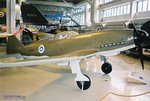Clay_Allison
Staff Sergeant
- 1,154
- Dec 24, 2008
Just prior to the war there existed a concept that many governments toyed with. A light fighter plane, made of non-strategic materials (plywood) and dragged around the sky by a Rolls Royce Kestrel, Junkers Jumo or HS 12Y, engines too weak to power a modern full size fighter but at one time in plentiful supply. If a fighter plane is the sports car of the air, this concept was the motorcycle.
The English, caught with their pants down in the BoB were nearly forced to revert to arming advanced trainers (the Miles Master) and toyed with making a plane that went from a blank piece of paper to its first flight in 2 weeks (the Miles M.20).
The French had three companies try to come up with something and the best of them was the Arsenal VG-33. It was nice looking fighter, evoking images of some of the pretty and fun to fly but pathetically underarmed Italian fighters. Apparently it could have been built in incredible numbers and was to be powered by an Allison had the idea not arrived when Hitler was sitting in a railroad car accepting French surrender.
My question is, did this idea have any merit?
Assume for a moment that you are a country starved of fighters that needs them (Australia or Finland for example) and this idea comes to you in time to get the project rolling (1935 for example). Assume you can get the engines (say a license Allison V-1710, Klimov 105 or DB-600 depending on your alliance), you can build the fighters, and you can arm them with at least a pair of good 20mm cannon. Remember that when you replace them with better fighters later in the war, they could continue to be good advanced trainers.
If you were the head of the war department of X-Country would you approve of such a program, or was this a concept that looks good on paper but only ends in tears?
The English, caught with their pants down in the BoB were nearly forced to revert to arming advanced trainers (the Miles Master) and toyed with making a plane that went from a blank piece of paper to its first flight in 2 weeks (the Miles M.20).
The French had three companies try to come up with something and the best of them was the Arsenal VG-33. It was nice looking fighter, evoking images of some of the pretty and fun to fly but pathetically underarmed Italian fighters. Apparently it could have been built in incredible numbers and was to be powered by an Allison had the idea not arrived when Hitler was sitting in a railroad car accepting French surrender.
My question is, did this idea have any merit?
Assume for a moment that you are a country starved of fighters that needs them (Australia or Finland for example) and this idea comes to you in time to get the project rolling (1935 for example). Assume you can get the engines (say a license Allison V-1710, Klimov 105 or DB-600 depending on your alliance), you can build the fighters, and you can arm them with at least a pair of good 20mm cannon. Remember that when you replace them with better fighters later in the war, they could continue to be good advanced trainers.
If you were the head of the war department of X-Country would you approve of such a program, or was this a concept that looks good on paper but only ends in tears?


